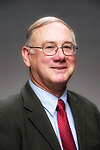Exciting times for IARC
 |
|
Bob Kephart
|
Bob Kephart, director of the Illinois Accelerator Research Center, wrote this column.
A blur of activity surrounding IARC has occurred since my last article in December. These are indeed exciting times!
With steady progress being made on the IARC physical plant and the monumental task of removing old CDF experimental equipment behind us, the Accelerator Division has taken over as landlord of the new complex. FESS' refurbishment of the former CDF Heavy Assembly Building for its new role within IARC is in full swing. The high bay space will be available for first projects by the end of the summer, and the HAB office-technical block is slated for completion in 2016.
This month represents a major milestone as the first new occupants move into the state-funded IARC office building. The IARC and Office of Partnerships and Technology Transfer (OPTT) teams are moving in, even as you read this article. We will serve as pathfinders, followed shortly by the PIP-II Project Office in June. We are even more excited to welcome our first university and industry partners in the fall.
For the past several months, the IARC team has been discussing partnership opportunities with groups that are less familiar to Fermilab. In collaboration with industry and several other laboratories, we submitted a number of concept papers in response to the 2015 ARPA-E open funding announcement in February, underlining the interest of industry in partnering with us on new energy solutions leveraging accelerator technology. We learned last week that one of these concepts has been selected to proceed to a full proposal, the first and most difficult hurdle on the way to new resources! The 2015 round of SBIRs was equally exciting: Fermilab wrote a record 34 support letters for new Phase I proposals and learned that four of seven Phase II proposals we supported received awards.
In late April, together with Argonne, Fermilab hosted the Midwest outreach meeting for the DOE Accelerator Stewardship Test Facility Pilot Program (ASTFPP). This event attracted 100 attendees, with 30 from industry, 10 from universities, and numerous others from Chicago and Illinois innovation organizations. The 2015 ASTFPP will fund lab-university-industry partnerships that leverage the unique accelerator capabilities and accelerator infrastructure at the national labs. We are already working with industrial partners to create proposals with the goal of securing our participation in ASTFPP by the end of this fiscal year. This event was immediately followed by Illinois Innovation Day in Springfield, then the International Particle Accelerator Conference in Richmond, Virginia. Next month we attend the National Innovation Summit where we will meet a wide variety of potential partners for Fermilab's accelerator expertise.
We have also been busy reaching out to new agencies and departments within the federal government. Our outreach efforts have sparked the interest of a wide range of agencies and programs, including the Department of Homeland Security, the Environmental Protection Agency, the Federal Highways Administration, DOE Fossil Energy, DOE Environmental Management and DOE Advanced Manufacturing.
While securing resources for these new initiatives is important, it is not enough. Achieving success at IARC requires a whole new way of doing business. Industry partners expect highly agile business processes, superior protection of potentially valuable intellectual property and excellence in project execution to meet the demands of a dynamic commercial market. That is why we have been working closely with OPTT, Finance and the Office of General Counsel to establish the business systems that will meet industry expectations.
I closed my last article reminding us all of the fundamental question about IARC: "If we build it, will they come?" The IARC program will be more a campaign than a project. It will take time, but more and more it looks like the answer is yes!
|